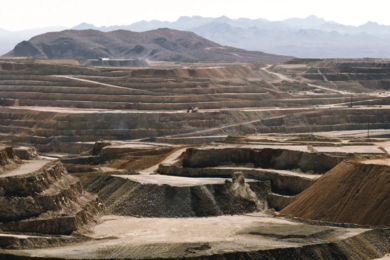More specifics on one of the major miners set to get Caterpillar’s highly anticipated early learner battery electric haul trucks. In its just published 2023 Sustainability Report, Freeport McMoRan says that it is “planning a trial with Caterpillar of an electric prototype truck at Sierrita in late 2024.” This will be among a group of early learner battery trucks heading out to key customers from Caterpillar this year – Newmont has already said it will be getting one at Cripple Creek & Victor (CC&V) gold mine in Colorado. Additional early learner units are heading to mines operated by BHP, Rio Tinto and Teck amongst others.
Caterpillar’s Early Learner program launched in 2021 and the OEM says focuses on accelerating the development and validation of Caterpillar’s battery electric trucks at participating customers’ sites. It adds: “This approach supports the individual commitments each Early Learner participant has made to reduce and eliminate greenhouse gas emissions from their operations. A primary objective of the program is for Caterpillar to collaborate more closely with its customers as the industry undergoes transformational change through the energy transition.”
Sierrita is an open pit copper and molybdenum mine located 20 miles southwest of Tucson, Arizona. It is fitting that this mine be one of the first to get an early learner unit – Caterpillar’s first battery electric prototype that was demonstrated in 2022 to customers including Freeport is based on the 793 platform and the first Cat 793 truck ever built was put into service at Sierrita back in 1991. The mine still operates a 793 fleet today. Plus Sierrita is next door to Caterpillar’s Tucson Proving Ground in Green Valley where the prototype battery truck was showcased as well as the Cat Tinaja Hills Demonstration & Learning Center.
The operation includes a 100,000 t/d concentrator that produces copper and molybdenum concentrate. Sierrita also produces copper from a ROM oxide-leaching system. Cathode copper is plated at the Twin Buttes EW facility, which has a design capacity of approximately 50 million pounds of copper per year. The Sierrita operation also has molybdenum facilities consisting of a leaching circuit, two molybdenum roasters and a packaging facility. The molybdenum facilities process molybdenum concentrate produced by Sierrita, from Freeport’s other mines and from third-party sources.
Overall, Freeport says its current fleet of haul trucks accounts for approximately 75% of its annual diesel fuel consumption. It says: “Transitioning the fleet away from diesel to lower emissions alternatives will require new technological solutions and innovations — many of which will be driven by industry and value chain collaboration. For the past several years, we have been trialing and simulating various truck models and scenarios, including alternative fuels, payloads, and enabling technology such as trolley assist and autonomous haulage systems in order to define the potential benefits of converting our fleet.”
In addition to Caterpillar’s Early Learner program, Freeport is also a participant in Komatsu’s GHG Alliance, which is also focused on the development and advancement of zero-emissions mining trucks and supporting technologies and infrastructure. Freeport has been trialling both Komatsu and Caterpillar hybrid drive ultra-class haul trucks at Cerro Verde adding that these diesel-electric trucks provide a more flexible platform for the future as it evaluates and considers enabling technologies, such as trolley assist systems. “These trials and various simulations demonstrate the potential to reduce fuel use by 20% to 30% compared to mechanical-drive trucks.”
In 2023, Freeport also announced plans to convert its fleet of approximately 30 haul trucks at the Bagdad mine in Arizona to fully autonomous over the next three years. This project is expected to optimise the fleet, improve operating efficiency and contribute to safety by reducing the number of people in active mining areas. “Our preliminary estimates show that Bagdad’s haul trucks could reduce idle time by more than 10,000 hours per year, which is expected to contribute to a reduction in GHG emissions. Although commercially viable innovation in electrification of haul trucks on a large-scale is still years in the future, we believe this project will position us to capitalise on future technological advancements in electrification.”










